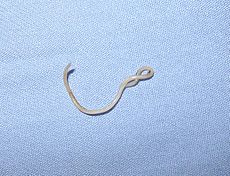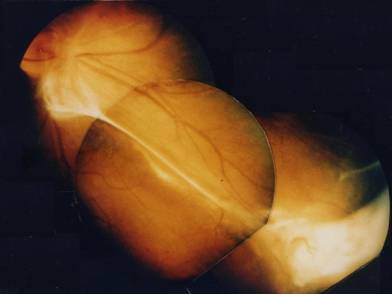Children, and even adults involved in gardening and other similar activities involving handling soil and dirt, often suffer from a type of infection that is characterized by fever, headaches, abdominal pain and other physical problems. This is known as Toxocariasis. Read and know all about the possible causes, symptoms, diagnosis, treatment and preventive options for this disorder.
Toxocariasis Definition
Page Contents
- 1 Toxocariasis Definition
- 2 Toxocariasis ICD9 Code
- 3 Toxocariasis Types
- 4 Toxocariasis Incidence
- 5 Toxocariasis Symptoms
- 6 Toxocariasis Causes
- 7 Toxocariasis Risk Factors
- 8 Toxocariasis Diagnosis
- 9 Toxocariasis Treatment
- 10 Toxocariasis Prognosis
- 11 Toxocariasis Complications
- 12 Toxocariasis Prevention
- 13 Toxocariasis Pictures
It is an infection caused by parasitic roundworms, medically referred to as Toxocara, which can be found in the intestines of dogs and cats. It is most common in young children who are exposed to dirt.
The disease is also referred to by various other names, such as:
- Covert toxocariasis
- Toxocara canis
- Toxocara cati
- Toxocarosis
- Ocular larva migrans
- Visceral larva migrans
The prevalence of this disorder is supposed to have a relation to geographic locations as it is found to be more prevalent in hot, humid areas where eggs are kept viable in the soil.
Toxocariasis ICD9 Code
The ICD9 Code for the disorder is 128.0.
Toxocariasis Types
The condition is classified into three types:
Covert Toxocariasis
As the name indicates, the symptoms associated to this type of the disorder are short-term and mild in nature. Patients with this form may suffer from headache, cough or mild abdominal pain. This is a mild, febrile and subclinical disease.
Visceral Toxocariasis
It arises when eggs hatch and spread all through the body, resulting in swelling of the skin, heart, lungs or even the brain. The condition is also known as Visceral larva migrans. In occasional cases, the condition has been known to give rise to pleural effusions and Chronic urticaria.
Ocular Toxocariasis
It occurs in those occasional cases when larvae spread to the eyes, causing redness and blurred vision. This form of the disease is also referred to as Ocular larva migrans. It tends to arise in older kids and young adults.
Toxocariasis Incidence
The condition has a worldwide prevalence, although most cases of it arise in places where cats and dogs are kept very near to human beings. The majority of cases are reported from regions like:
- Australia
- East and Western Europe
- Hawaii
- Mexico
- Philippines
- South Africa
- Southeastern United States
This is a rare type of infection. The Health Protection Agency (HPA) recorded only 30 cases of the disease in England and Wales between the years 2000 and 2010. The exact prevalence and incidence of this disorder is hard to determine. It is difficult to exactly assess how many cases of Toxocariasis occur every year as the disease is often undiagnosed or even misdiagnosed. It is possible that many more individuals have been exposed to such parasites without being aware.
Toxocariasis Symptoms
The majority of individuals suffering from this disorder are asymptomatic. In other words, they do not exhibit any signs and symptoms. Even if symptoms occur, they may include problems like fever, seizures and cough or wheezing.
Other symptoms may include:
- Rash
- Loss of appetite
- Abdominal pain
- Enlarged lymph nodes
- Enlarged liver or spleen
The infection can also affect the eyes and result in problems like:
- Cross-eyed appearance
- Headaches
- Reduced vision
- Inflammation around the eyes
In rare cases, the roundworm larvae can infect organs like the brain, eyes, liver or lungs and can result in acute symptoms such as:
- Fatigue
- Respiratory difficulties
- Loss of appetite
- Cloudy or blurred vision in one eye
Toxocariasis Causes
In humans, the disorder can arise as a result of migration of the larvae of Dog roundworm (Toxocara canis) and less commonly due to cat roundworm (T. cati) through the tissues of human body. Toxocara are nematode parasites of animals. Humans become infected by the microbe due to accidental ingestion of eggs in soil that is contaminated by feces of dogs. Although they never mature in human beings, larvae hatch out in the small intestine and tend to migrate through the lungs and the liver to other tissues. In the majority of cases, the larvae are possibly eliminated although a surrounding granuloma may develop in certain sufferers.
In rare circumstances, T. cati can mature in human beings and get transmitted through feces or vomit. However, sufferers with adult T. cati do not have antecedent symptoms, antibodies or eosinophilia. This indicates that they are acquired due to ingestion of adult worms or advanced larval stages from feces or cat vomit.
Toxocariasis Risk Factors
The risk factors for this disorder include the following:
- Dwelling in rural areas
- Cohabitation with cats and dogs
- Socioeconomic deprivation
- Eating without washing of hands
- Travel to regions with high prevalence of the condition
- Contact with soil contaminated with dog feces
Kids are at greatest risk of contracting this disease as they may accidentally ingest soil with contaminated eggs in playgrounds.
Toxocariasis Diagnosis
The diagnosis of the disorder can be very difficult as the majority of its symptoms are mild and nonspecific in nature. The common indicators of infection are:
- Hepatomegaly
- Chronic eosinophilia
- Chronic pulmonary disease
- History of exposure to puppies
- Contact with feces-contaminated soil
The disease is usually detected through a blood test. Blood tests look for evidence of infection with Toxocara larvae. Apart from blood test, diagnosis of the condition involves detecting the presence of typical clinical symptoms of OT or VT and knowing about history of possible exposure to dogs and cats. In order to infer diagnosis, clinicians use serologic testing such as Immunoblot or ELISA (Enzyme-linked Immunosorbent Assay).
In the majority of cases, no treatment is required. Some medicines that are useful for Toxocariasis patients may be used to remove the infection.
If a physician suspects visceral or ocular larva migrans, he or she may conduct CT scans of the inner organs to analyze the extent of damage.
Toxocariasis Differential Diagnosis
The signs of this disorder resemble those of a variety of other conditions, which adds to the difficulty of diagnosing Toxocariasis. Doctors should take all possible measures to isolate the symptoms of the condition from those of these similar diseases like:
Differential diagnosis of visceral form
This includes distinguishing the symptoms from those of the following disorders:
- Other causes of Acute hepatitis
- Angioedema
- Adverse drug reactions
- Allergic bronchopulmonary aspergillosis
- Eosinophilic pneumonia
- Hypereosinophilic syndrome
- Pulmonary eosinophilia
- Systemic lupus erythematosus
- Other helminthic infestations
Differential diagnosis of ocular form
This includes distinguishing the symptoms from those of Retinoblastoma.
Toxocariasis Treatment
The treatment for this disease is based on the form of the infection and the severity of the symptoms. Cases of Visceral Toxocariasis can be cured with the aid of antiparasitic medications like Mebendazole or Albendazole. Corticosteroids play an important role in suppressing acute allergic manifestations of the disorder.
The treatment of Ocular Toxocariasis is harder and generally involves measures to prevent progressive damage to the eye. Corticosteroids have a significant role to play even in the treatment of this form.
Most cases of covert Toxocariasis are not medically treated. The larvae are naturally expelled in bowel movements over a period of few weeks. If there is a spread of the roundworm larvae, a doctor can prescribe medications known as anthelminitics to detect and destroy parasites that are present in the bloodstream of patients. Anti-inflammatory drugs can help provide relief from other symptoms associated to infection.
In rare cases where parasites result in severe damage to eyes or organs, surgery may be required to remove or repair parts of the body that have been affected.
Toxocariasis Prognosis
Fortunately, the condition generally carries a very good prognosis. The outcome is variable in case of patients of the ocular form of the disorder. The prognosis is generally good in the visceral form. The majority of patients are found to recover without medical treatment.
Toxocariasis Complications
Uniocular visual loss is not infrequent in cases of Ocular Toxocariasis. In severe cases of Visceral Toxocariasis, prominent organ damage and even death can occur.
Toxocariasis Prevention
Controlling Toxocara infection in cats and dogs can reduce the number of infectious eggs in the surroundings and decrease the risk of infection for sufferers. Veterinarians should be hired to cure cats and dogs, particularly those of young age, to regularly check for the presence of worms. This is particularly necessary in cases where pets spend a lot of time in outdoor environment and have the risk of becoming infected again.
Practicing certain measures can increase the chance of safety for pets and even human beings around them. These include:
- Cleaning the living area of pets at least once every week.
- Teaching children the importance of washing hands in order to prevent infection.
- Teaching children the dangers of eating soil or dirt.
- Removing all traces of animal feces from the home and surroundings. Feces should be disposed of in the trash, bagged or buried.
- Washing hands after handling pet waste.
- Not allowing children to play in regions soiled with feces of pets or other animals.
- Putting a cover on unused sandboxes to ensure that animals do not get inside and contaminate them.
- Washing hands with soap and warm water after playing with animals or pets after outdoor activities or before cooking/eating.
The presence of a strong protective layer allows Toxocara eggs the ability to survive for months or even years in appropriate living conditions. Although common disinfectants are ineffective against Toxocara eggs although high heat has been found to destroy them. Immediate removal of animal feces can help prevent infection as 2-4 weeks are necessary for eggs to get infective once they are out of the body of animals.
The eradication of T. canis infection is difficult due to the complexity of the life cycle of the microbe. However, practicing good hygiene can help reduce the risk of infection in humans.
Toxocariasis Pictures
Check out the following images associated to this disorder.
Picture 1 – Toxocariasis
Picture 2 – Toxocariasis Image
If you suspect yourself or your child to be suffering from Toxocariasis, get in touch with a medical professional to discuss the possibility of infection and undergo diagnosis, if required. As aforesaid, the condition even involves loss of vision and death in severe cases. Naturally, it is safe to seek prompt medical attention and avert the risk of all possible complications associated to the disorder and also ensure early recovery.
References:
http://www.nhs.uk/Conditions/Toxocariasis/Pages/Introduction.aspx
http://en.wikipedia.org/wiki/Toxocariasis
http://www.patient.co.uk/doctor/Toxicariasis.htm
http://emedicine.medscape.com/article/229855-overview


